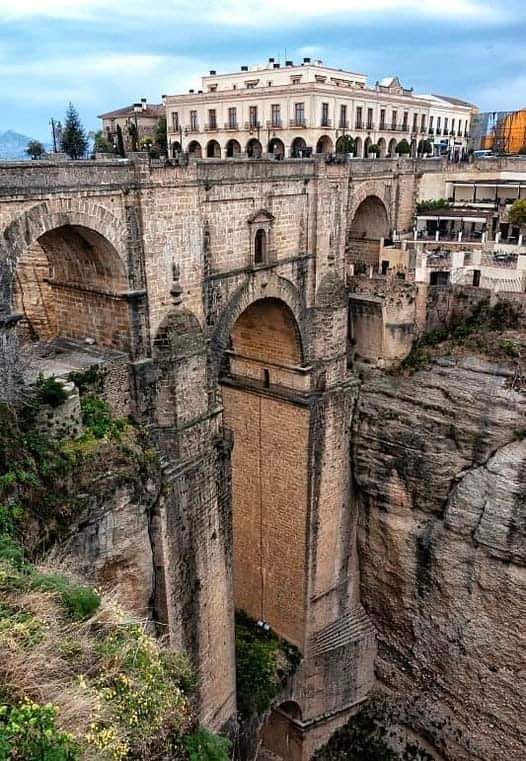Perched high at an elevation of 750 meters above sea level in the Malaga Province of southern Spain, the ancient city of Ronda is a stunning blend of natural wonder, historical richness, and cultural depth. This breathtaking city, dramatically split by the El Tajo Canyon, draws travelers from around the world with its iconic cliffside views and centuries-old legacy. As you stand at the edge of its famous gorge or wander through its historic streets, Ronda reveals itself not just as a destination, but as a living storybook chronicling the passage of civilizations and the blending of cultures across time.

The roots of Ronda trace back to the 6th century BC, when the Celts, recognizing the strategic significance of its mountainous setting, first settled the area. They established a foothold in the region, laying the groundwork for a settlement that would endure and evolve through successive civilizations. When the Romans arrived, they further fortified the city, acknowledging its military and geographical value. Julius Caesar is said to have played a key role in enhancing Ronda’s defenses, solidifying its place in the Roman Empire. Yet perhaps the most transformative moment in Ronda’s history came in 713 AD, when the Moors swept into the Iberian Peninsula. Under Moorish rule, Ronda was renamed Izn-Rand Onda, meaning “city of the castle,” and was elevated to the capital of the Takurunna Province. This period brought a flourish of Islamic art, architecture, and urban development that still shapes the city’s appearance and spirit today.
One of the most striking features of Ronda is its trio of historic bridges that span the sheer cliffs of El Tajo Canyon, each one telling a chapter of the city’s story. The Puente Romano, or Roman Bridge, although modified over time, harks back to the earliest architectural efforts of Roman engineers and reflects the enduring influence of that era. The Puente Viejo, or Old Bridge, dating from the Moorish period, adds an Islamic architectural layer to the city’s infrastructure. But it’s the Puente Nuevo, or New Bridge, that truly captures the imagination. Completed in the late 18th century, this 120-meter-tall marvel of engineering connects Ronda’s old and new towns, offering jaw-dropping views into the canyon below and standing as a testament to the ingenuity of Spanish architects during the Enlightenment period.
As you stroll through Ronda’s winding streets, you encounter a seamless fusion of cultures that have shaped the city over millennia. The legacy of the Moors is evident in the whitewashed facades, arched doorways, and detailed tilework that adorn the city’s buildings. One of the finest examples of this Islamic heritage is the Palacio de Mondragón, a former Moorish palace that now houses a museum. Its ornate gardens and intricate courtyards whisper tales of a once-glorious Islamic dynasty. But as history moved forward, the Renaissance introduced a new wave of artistic and architectural transformation. The Church of Santa Maria la Mayor, for instance, was constructed atop a former mosque, symbolizing the cultural shift from Islamic to Christian Spain. Its Gothic and Baroque elements embody the religious and social changes that defined Spain’s post-Reconquista era.
Beyond its architecture, Ronda thrives as a hub of Andalusian culture and tradition. The city is home to the Plaza de Toros de Ronda, one of Spain’s oldest and most historically significant bullrings. This arena not only preserves the art of bullfighting but also serves as a monument to a tradition that has both captivated and divided generations. Ronda’s cuisine, too, speaks to its rich heritage. Dishes such as rabo de toro (oxtail stew) and locally produced wines reflect centuries-old culinary traditions passed down through families. Meanwhile, the soulful rhythms of flamenco still echo through the courtyards and taverns, a powerful reminder of the region’s emotional depth and musical legacy.
Ronda is also a gateway to some of Andalusia’s most picturesque white villages, or pueblos blancos. From this central location, travelers can venture into the Sierra de Grazalema and Sierra de las Nieves mountain ranges, where charming towns like Grazalema, Zahara de la Sierra, and Setenil de las Bodegas offer a more intimate glimpse into rural Spanish life. These villages, known for their pristine whitewashed homes, handcraft traditions, and tight-knit communities, preserve the soul of old-world Andalusia. Each village carries its own personality, reflected in local festivals, culinary specialties, and artisanal crafts that have withstood the test of time.
In the present day, Ronda stands not merely as a relic of the past, but as a vibrant, living museum that continues to evolve while honoring its storied legacy. The city is an extraordinary convergence of ancient and modern, where every alleyway, stone wall, and sweeping vista tells a tale. Whether you’re gazing across the gorge from the Puente Nuevo, exploring the courtyards of Moorish palaces, or simply sipping a glass of wine in a sunlit plaza, you are participating in a timeless narrative woven across cultures and centuries.
What makes Ronda truly exceptional is the sense of timelessness that envelops you at every turn. It is more than a place of interest—it is a deep, sensory journey into the soul of Andalusia. With its dramatic cliffs, layered history, and cultural richness, Ronda doesn’t just preserve the past—it brings it vividly to life. Every stone in Ronda has borne witness to the rise and fall of empires. Every path you walk echoes with stories of ancient civilizations. Every sunset over the canyon feels like a moment suspended in time. Here, history is not confined to museums or textbooks—it breathes in the city’s walls, its people, and its enduring spirit. Ronda is, without question, one of Spain’s most treasured gems, a place where history and beauty merge to leave a lasting imprint on all who visit.





